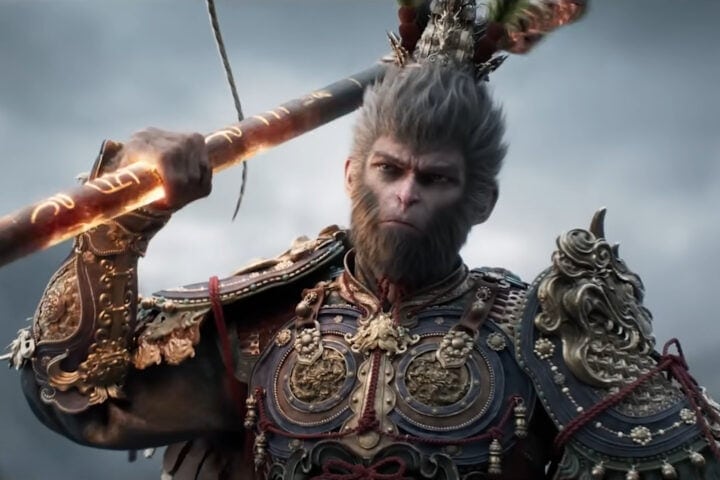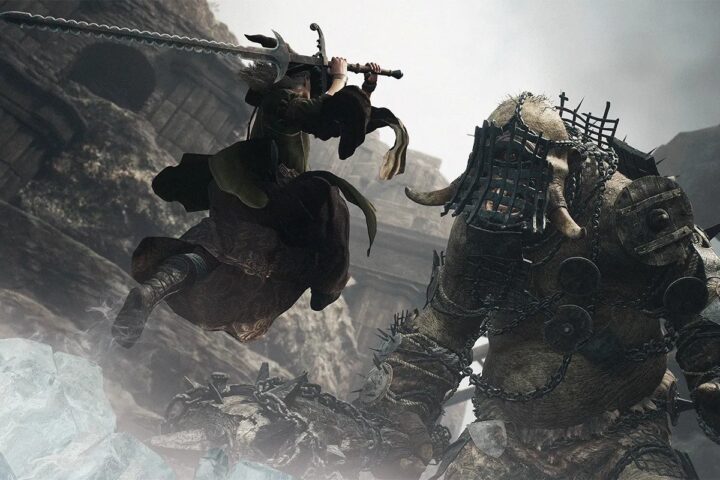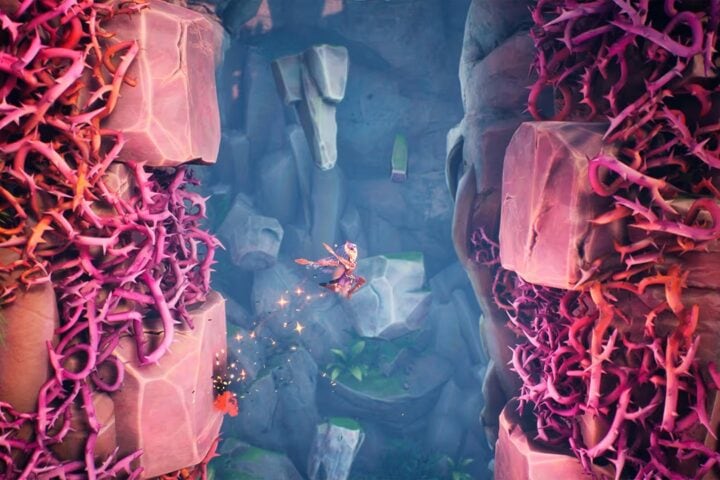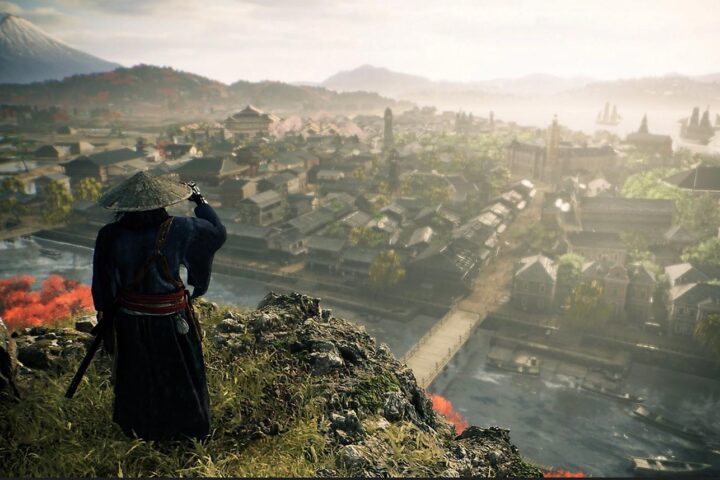With Another Crab’s Treasure, developer Aggro Crab has created an effective Trojan seahorse of a game. The underwater world skillfully evokes the lighthearted charm of Banjo-Kazooie, filled as it is with colorful landscapes populated by googly eyed critters who speak in mumbled gibberish. But that cartoonish sheen belies a vicious ecosystem whose methodical violence and apocalyptic ethos recall the work of Miyazaki Hidetaka. The result is an absorbing, if uneven, action RPG that largely threads the needle between cozy and thrilling.
The game’s opening introduces us to Kril, an introverted hermit crab whose shell is being repossessed off his back. The (loan) shark nabbing his home claims that Kril owes taxes to a nearby fiefdom, and our mystified hero has some questions. “First of all, what’s a ‘duchy’? Also, ‘taxes’?” Kril then finds a makeshift weapon—a fork—and sets out to reclaim his property.
Thus does Kril learn that his fellow ocean dwellers are, sadly, replicating humankind’s dismal experiments in social structure, as evident in the feudal rule of the noble demanding Kril’s tribute and, later, the tyranny of a robber baron over a dead-end company town. Kril’s quest also exposes him to the more physical byproducts of our evolution: Cigarettes, smashed beer cans, and batteries litter the seabed, while sludge renders swathes of land uninhabitable. But the denizens of the deep are resourceful. They turn endless receipts into roads in the metropolitan New Carcinia, use floss picks as walking sticks, and even trade microplastics as currency.
The fauna wise up when pollution starts to turn their friends feral. And so, as you explore vibrant locales—cutting through the water at a delightful velocity and gliding along platforming sequences with the help of a grappling hook—you must put beasts to the fork.
The game’s combat and adjacent systems are plainly, and thoroughly, inspired by FromSoftware’s Souls titles. The similarities are too numerous to name in full, but in a nutshell: You lock onto enemies, watch out for colored symbols that foreshadow special moves, and build up a stagger bar in the hopes of “capsizing” your target for bonus damage; you recharge your limited healing items at checkpoints where you can also level up and fast travel; and upon death, you lose your money (microplastics), which you can recover by returning to Kril’s corpse. (In a notable departure, the game offers a suite of options to customize its difficulty.)
The game reaches into the Souls grab bag with winking playfulness (there’s a region in the game called “the Sands Between”) and confidence in the thematic resonance of its borrowing act. After all, hermit crabs do not form their own shells. They find them in the wild, settle into them, and, sometimes, fight for them. Who are we to disrupt the natural order of things?
It helps that a number of fresh ideas prevent the proceedings from feeling overly familiar. Kril can don a creative array of everyday objects as temporary shells—from banana peels to busted tennis balls to Rubik’s Cubes—that grant him defensive stats. Each shell also provides an active ability, like a Goron-esque high-speed roll and a decoy that distracts foes. In a smart design choice, Kril’s regular attacks charge up the magic meter—or “umami”—that fuels his shell spells, enabling a compelling blend of fork prodding and sorcery.
And though the limited durability of shells bears shades, in the occasional inopportune shattering, of The Legend of Zelda: Breath of the Wild and its sequel, the transience of your armor encourages experimentation and versatility while making tangible the conviction of Kril’s crusade. No shell will do but the one that’s rightfully his.
Kril’s magic is bolstered by “adaptations,” punchy powers earned by defeating certain bosses, and a skill tree gradually unlocks new capabilities. Some of the skills feel unnecessarily walled off—including Kril’s parry and the technique that lets him land whammies on knocked-down opponents—and the novelty of Kril’s shell collection fades as spells get repeated across models. But there’s just enough variety, and a sufficiently steady drip of additional mechanics, for combat to stay satisfying for the game’s lean playtime (expect 10-20 hours for completion).
The later Souls titles, despite their commitment to difficulty and comfort with repetition, often sand down player friction. Another Crab’s Treasure stumbles on that front. When dying to a boss, you’re thankfully given the option to respawn immediately outside of their arena, but intro cutscenes repeat on subsequent attempts, which grows irritating in especially tough encounters. Meanwhile, rather than being able to simply use the items that instantly add to your microplastics, you need to return to the hub of New Carcinia to sell them, elongating what could have been quick level ups with an extra couple of loading screens.
The greatest frustrations of Another Crab’s Treasure lie in its last act, which reaches for a world-upending twist in the vein of Sekiro: Shadows Die Twice’s immolation of Ashina Castle and the reveal of the eldritch colossi in Bloodborne. The pivot is narratively and visually intriguing, but in pursuit of a challenge that matches its grimmer tone, the game concocts exhaustingly circuitous environments that are patrolled by irritating enemies. It’s all further weighed down by the prettily illustrated but almost useless map, which doesn’t reveal anything beyond your closest surroundings, and thereby provides little relief from disorientation.
These issues dull but don’t overpower the game’s endearing highs. Save a couple of exceptions, bosses are quite fun to learn and imaginatively depicted, like the hulking crab you fight on a wooden ship that once sailed the tables of a sushi restaurant. The imposing figure and its idiosyncratic domain fit right into the oddball world that Aggro Crab realizes with each droll NPC and surprisingly impressive marine pun. (The winner: “Codspeed.”)
The game’s quirky sensibility lends amusing irony to its critique of modern industry’s environmental destruction. Where item descriptions in the Dark Souls series and its ilk flesh out the esoteric lore of their settings, here they offer a crab’s-eye view of life on the surface. “Residue of a painful venom lines the outside of this armor,” reads the blurb about the nozzle of a hot sauce bottle that Kril can equip as a shell. As Another Crab’s Treasure conjures a universe in which the vast horde of trash sunk carelessly into the sea might have its benefits, the game pokes countless holes in its fantasy, letting reality flood in: No amount of make-believe can render humankind’s impact on the Earth anything but poisonous.
This game was reviewed with code provided by popagenda.
Since 2001, we've brought you uncompromising, candid takes on the world of film, music, television, video games, theater, and more. Independently owned and operated publications like Slant have been hit hard in recent years, but we’re committed to keeping our content free and accessible—meaning no paywalls or fees.
If you like what we do, please consider subscribing to our Patreon or making a donation.





